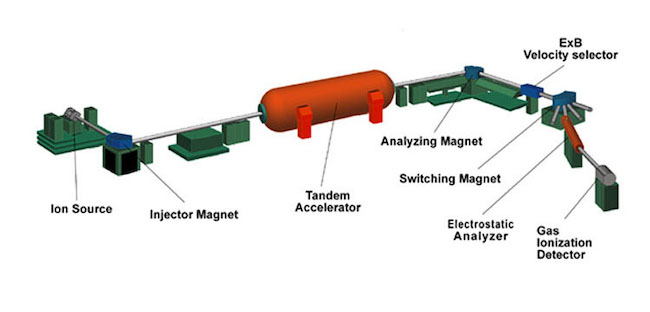In 1960 Willard Frank Libby was awarded the Nobel Prize for his method of using carbon-14 to find the age of objects ranging from ancient bows and arrows to trees buried in glacial ice. Since then, the technique of radiocarbon dating has been improved so that it can be used with much smaller samples---fractions of milligrams instead of the original 8 grams. This has made it less intrusive when dealing with precious art and in trying to figure out the authenticity of artefacts like the Shroud of Turin. Whereas, Libby modestly assumed that radiocarbon dating’s upper limit was 20 000 years old, it can currently estimate the age of objects as old as 55000 years old.
Carbon has 15 isotopes, of which only 3 are natural: 12C, 13C, 14C. The superscript refers to the sum of neutrons and protons in each atom. Any atom is characterized by its number of protons, so the trio of carbon’s isotopes 12C, 13C, 14C, have 6 protons each, but they contain 6, 7 and 8 neutrons, respectively. That last number seems to be too much for a nucleus to handle. Every 5730 ± 40 years, in half of 14C nuclei, a neutron transforms into a proton, an antielectron neutrino and a beta particle, becoming 14N in the process, the common isotope of nitrogen in the air. A beta particle is a highly energetic electron and is a form of radiation identical to what old “cathode ray” television sets and computer screens emitted from their long bulky bodies; it was blocked by lead (Pb) in the glass screen. The reason some 14C exists on earth is that neutrons released from violent cosmic ray-collisions in the Earth’s upper atmosphere cause a small portion of 14N in the air to become hydrogen and 14C.
This property of 14C has been very useful in dating old samples of bones, charcoal, seeds, wall paintings and in just about anything containing carbon. While plants are still alive, through photosynthesis, they continuously absorb 14C from the small fraction of carbon dioxide which contains the isotope. This was first realized by Libby. Whether carbon dioxide contains 14C or the common 12C doesn’t affect the chemical properties of the vital gas. So plants can still use it to make glucose.
After organisms die, after bacterial decomposition, whatever 12C that remains behind does not undergo radioactive decay. Unlike 14C, 12C is a stable isotope. But 14C keeps transforming back into 14N. So the longer something has been dead, the less 14C it contains. The most efficient carbon-dating technique is accelerator mass spectrometry (AMS).

An accelerator mass spectrometer
https://www.physics.purdue.edu/primelab/
The 14C content is directly measured relative to the amount of 12C and to 13C present, which, like 12C, is also stable. From these ratios, the age of an object can be calculated. Unlike other methods, AMS does not measure the amount radiation emitted but determines the number of carbon atoms present in the sample and the age-dependent ratios. The 55000-year upper limit of radiocarbon-dating has only been reached in the past 15 years. As recently as 2008, the limit was a little less than half of that because sunspot activity affects the rate of cosmic rays reaching the earth, and hence the amount of 14C-formation in the atmosphere has not been constant. A calibration curve based on tree rings and their analyses takes the fluctuations into account. The improvement of the curve and the use of the AMS technique have been mainly responsible for giving the method more historical scope.
The Shroud of Turin is a linen cloth that Christian tradition associates with the crucifixion and burial of Jesus. In 1988, scientists at three separate laboratories used carbon-14 to date samples from the Shroud to be from 1260 to1390 AD, coinciding with the first verified appearance of the shroud in the 1350s. Given that the burial of Jesus was in 30 or 33 AD, the evidence strongly suggests that the Shroud is not the real McCoy.
35 years later, the 1988 tests continue to be debated. Is it because the conclusion clashed with longstanding belief about the cloth? About 10 years ago, Professor Christopher Ramsey of the Oxford Radiocarbon Accelerator Unit, one of three labs which carried out the research, said, "We're pretty confident in the radiocarbon dates. There are various hypotheses as to why the dates might not be correct, but none of them stack up.” More recently, in 2019, Phillip Ball, former chief editor of Nature, wrote, “Nothing published so far on the shroud, including this paper, offers compelling reason to think that the 1989 study was substantially wrong – but apparently it was not definitive either.” Given ever-improving techniques and rigorous statistical analyses, the bar can always be raised. But so far, more radiocarbon testing has not been given the OK by the Church. As Ball said, “As it stands, reticence looks more like fear of what further studies might reveal.”
Sources:
Nobel Prize Winners in Chemistry. Eduard Farber. Abelard-Schuman. 1962
https://www.nature.com/articles/s43586-021-00063-w.pdf
https://www.acs.org/education/whatischemistry/landmarks/radiocarbon-dating.html
https://www.ncbi.nlm.nih.gov/pmc/articles/PMC4853109/#b6-j92cur
https://www.chemistryworld.com/opinion/how-old-is-the-turin-shroud/30103...
Enrico Uva is a retired chemistry teacher who still enjoys learning chemistry, other sciences and mathematics.







